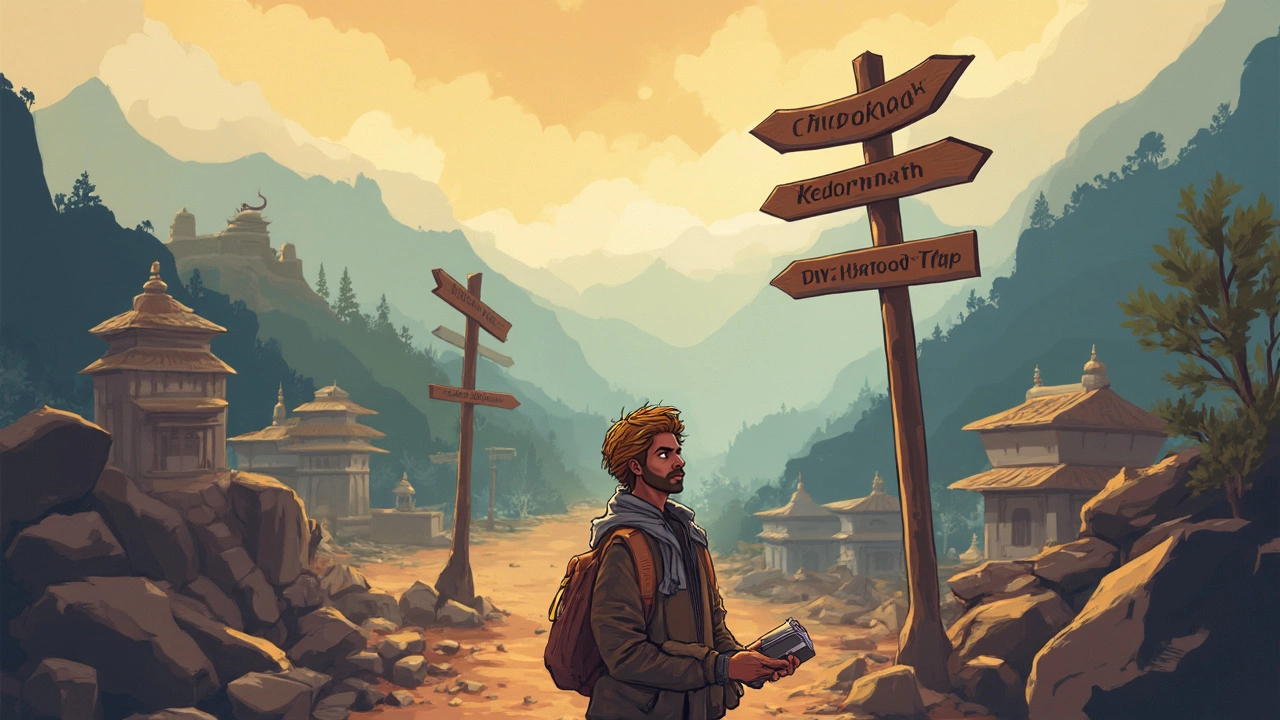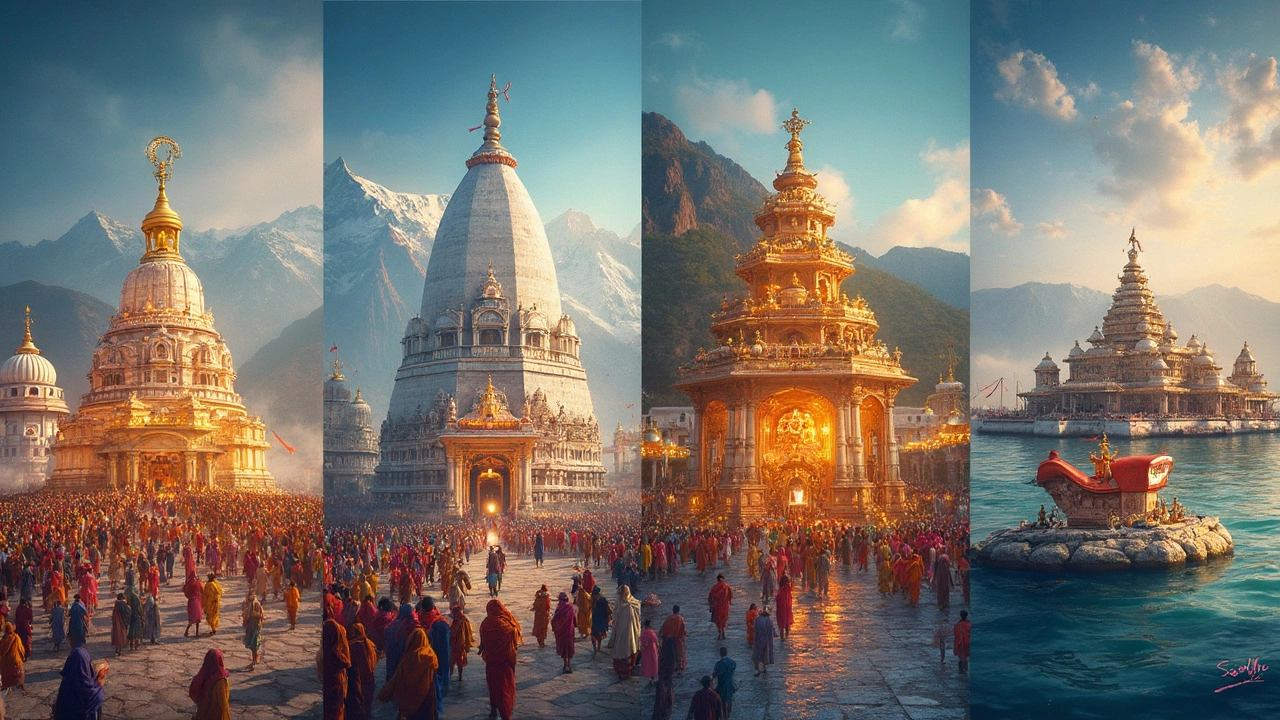If you ask ten people about India's Char Dham, chances are half of them will think Kedarnath is one of them. It's not. This mix-up happens more than you'd think, even among folks who’ve visited the temples. So here’s the deal—Char Dham and Chota Char Dham are two separate things, and Kedarnath belongs to just one of them.
Char Dham usually means the four shrines: Badrinath, Dwarka, Puri, and Rameswaram. They’re spread out all across India, and the idea was to visit the four corners of the country. But up in Uttarakhand, you’ve got Chota Char Dham: Yamunotri, Gangotri, Badrinath, and Kedarnath. Tour operators sometimes call the Uttarakhand circuit 'Char Dham Yatra,' which just adds fuel to the confusion.
If you’re planning a temple tour and want to hit all the classic spots, understanding this simple difference shakes up your itinerary. There’s no nationwide Char Dham yatra that officially includes Kedarnath—it’s only in the Uttarakhand version. Pretty wild, right?
- Char Dham vs Chota Char Dham: Clearing the Confusion
- Why Isn't Kedarnath Part of the Original Char Dham?
- Kedarnath's Unique Pilgrimage Identity
- Tips for Visiting Kedarnath and Other Pilgrimage Sites
Char Dham vs Chota Char Dham: Clearing the Confusion
The term Char Dham originally comes from Adi Shankaracharya, the famous philosopher, who mapped out four key pilgrimage sites in the 8th century. These are Badrinath in the North, Dwarka in the West, Puri in the East, and Rameswaram in the South. These four spots cover the length and breadth of India and, in the classic sense, that’s what “Char Dham” means.
The confusion actually starts with Uttarakhand tourism. Here, the holy route that covers Yamunotri, Gangotri, Kedarnath, and Badrinath is called “Chota Char Dham”—meaning “small four abodes.” Over time, travel agencies dropped the word 'Chota,' so people began calling this Himalayan circuit just “Char Dham.”
To clear it up in simple terms:
- Original Char Dham (Pan-India): Badrinath, Dwarka, Puri, Rameswaram
- Chota Char Dham (Uttarakhand): Yamunotri, Gangotri, Kedarnath, Badrinath
Kedarnath is in the Uttarakhand group, not the pan-India one.
Mixing up the terms has real effects. If you tell someone you did the Char Dham Yatra, some will picture you travelled across India, while others will think you just did the Himalayan circuit. Always double-check which one is being discussed—especially when booking tours, because the travel involved and level of preparation is very different for each.
So next time the subject comes up, you’ll know where each Kedarnath and Badrinath really fit in the big scheme of temple tours.
Why Isn't Kedarnath Part of the Original Char Dham?
People get confused because the names sound similar, but the original Char Dham has nothing to do with Kedarnath or even the Himalayas. When Adi Shankaracharya, one of India’s most famous spiritual leaders, set things up in the 8th century, he picked four places on the map. These spots—Badrinath in the north, Dwarka in the west, Puri in the east, and Rameswaram in the south—each represent a different part of India and a different form of God.
Kedarnath, though important, wasn’t one of Shankaracharya’s four main picks for the “big league” tour. It’s a Shiva temple, while the original Char Dham focuses more on Vishnu temples (except Rameswaram, which is dedicated to Shiva but tied closely with the Ramayana). That’s one of the reasons Kedarnath got left out of the list.
| Temple | State | Main Deity | Established by |
|---|---|---|---|
| Badrinath | Uttarakhand | Vishnu | Adi Shankaracharya |
| Dwarka | Gujarat | Krishna (Vishnu) | Adi Shankaracharya |
| Puri | Odisha | Jagannath (Vishnu) | Adi Shankaracharya |
| Rameswaram | Tamil Nadu | Shiva | Adi Shankaracharya |
Badrinath is the only temple in the north included, and that’s probably why folks mix it up with Kedarnath since both are in Uttarakhand and feel super remote. But from a historical point of view, the four original Char Dham sites were designed to cover the entire country, making pilgrims travel far and wide. That’s not the setup with Kedarnath.
- The original Char Dham is like the "grand slam" of pilgrimages—one in each direction.
- Kedarnath’s fame skyrocketed later, especially with the rise of the smaller, local versions of the pilgrimage circuit, like the Chota Char Dham in Uttarakhand.
- So, if you only visit Kedarnath, you’ve done an epic trip, but you haven’t ticked off the “main” Char Dham journey from the traditional Hindu list.

Kedarnath's Unique Pilgrimage Identity
Kedarnath stands out big time when it comes to Hindu temple tours. It’s not just another stop—it’s at the heart of the Chota Char Dham circuit in Uttarakhand. What makes it even more interesting is that it’s also one of the twelve Jyotirlingas, which puts it on the must-visit list for Shiva devotees all across India. You won’t find Kedarnath anywhere near the original Char Dham, but that hasn’t taken away from its serious reputation.
The temple sits at about 3,583 meters, often wrapped in snow or cold air, so the trip isn’t exactly easy. Pilgrims hike about 16 kilometers from Gaurikund, and there’s no direct road for cars or buses right to the top. It’s a real test of stamina and patience. That tough path is actually part of Kedarnath’s appeal—people feel like the effort itself is a form of worship.
Another thing: while most pilgrimages follow set rules, Kedarnath stands on its own with local traditions. The place opens only from late April or early May and closes by October, since heavy snow blocks the way for the rest of the year. When it shuts down, the deity is moved to Ukhimath; this tradition has gone on for centuries.
And here’s a quick tip, especially for first-timers: don’t forget that Kedarnath doesn’t operate like big temples in cities. You’ll need to sort out permits, pack for unpredictable weather, and plan for accommodation that gets booked out months in advance—no last-minute luxury stays here, only simple lodges. The focus is more on the spiritual experience than on comfort or amenities.
Tips for Visiting Kedarnath and Other Pilgrimage Sites
Getting to Kedarnath is no casual stroll. The main temple sits at 11,755 feet in the Himalayas, so you’re looking at a 16 to 18 km trek from Gaurikund. If you're not up for a long hike, there are pony, palanquin, and limited helicopter options, but these book up fast—especially during peak yatra season (May to June, then September to October).
Weather is extreme, with nights dropping below freezing even in summer. Warm layers aren’t optional. And don’t forget solid trekking shoes—those steep, stony stretches turn extra slippery when it rains. Most folks miss this detail and come unprepared, which is why there’s a busy first-aid post right near the top.
- Book travel and accommodation early: During yatra season, everything from hotels to helicopter tickets sells out months ahead. Only government-approved hotels are available near the temple; there’s no fancy lodging here.
- Carry only essentials on the trek: Stick to light clothes, a water bottle, sunscreen, a basic medicine kit, and some snacks. Heavy bags will just wear you out faster at high altitudes.
- Acclimatize properly: If you’re coming from the plains, plan to stop for a day at either Guptkashi or Sonprayag before heading up. Rapid ascents cause altitude sickness—don’t push it.
- Mobile and ATM woes: Only BSNL and Jio networks work, and even those are patchy. Cash is king after Sonprayag; card machines are almost non-existent.
- Dress code and temple etiquette: Keep it modest and follow instructions from priests. Photography inside the shrine is always banned.
| Travel Fact | Details |
|---|---|
| Best Time To Visit | May-June & Sep-Oct |
| Temple Altitude | 11,755 feet (3,584 m) |
| Trek Distance | 16-18 km (from Gaurikund) |
| Mobile Connectivity | Mostly BSNL/Jio only |
| ATM Availability | Sonprayag or lower |
If you plan to cover other Chota Char Dham spots (Yamunotri, Gangotri, and Badrinath), map your route in advance. These shrines each have their own quirks—like Yamunotri’s tough trek, Gangotri’s cold nights, and Badrinath’s high-altitude headaches. Keeping flexible dates helps when bad weather hits and roads close, which happens way more often than you’d expect (record: two weeks’ closure in May 2023 thanks to a landslide).
Pack prescription meds, double-check all bookings, and, if you’re traveling with elders or kids, plan for extra stopovers to let everyone catch their breath. The adventure is worth it, but good prep makes all the difference between a rough trip and a spiritual journey you’ll actually enjoy.
